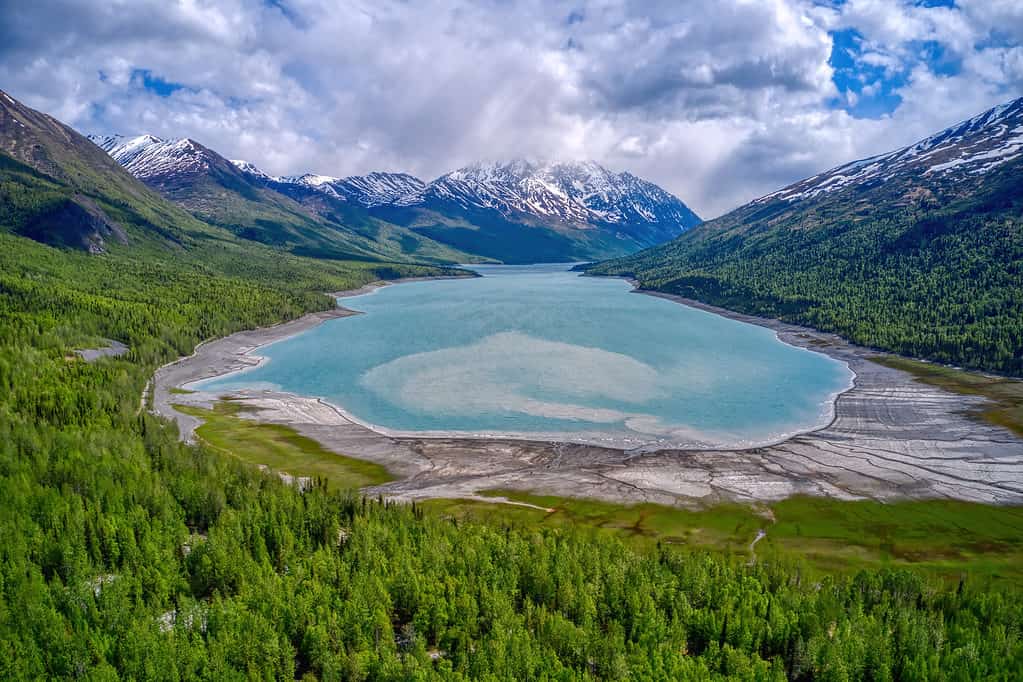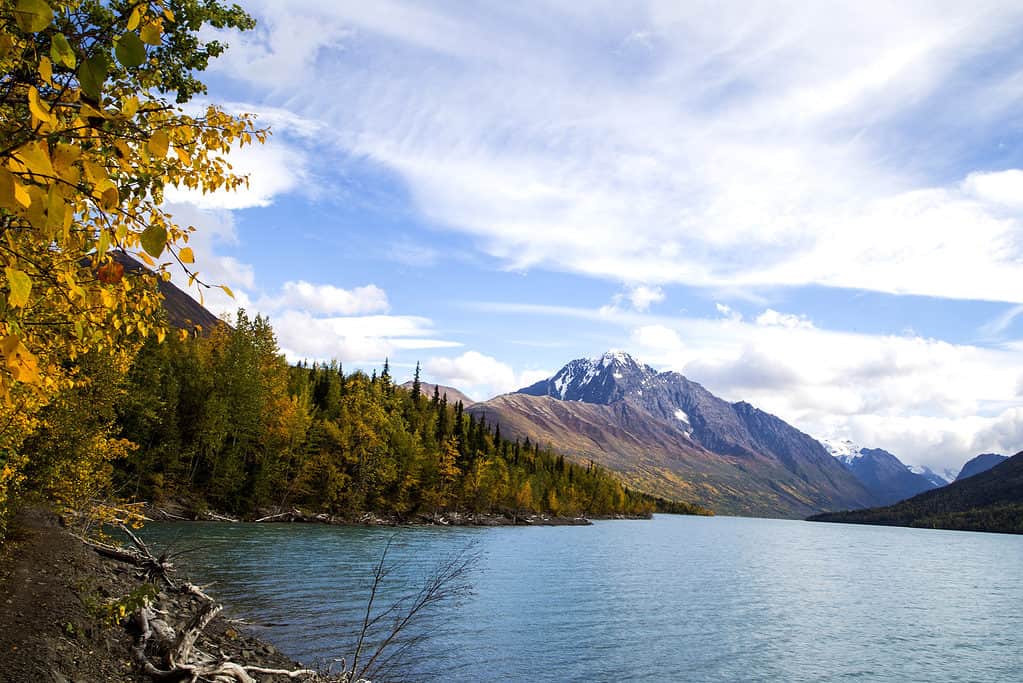Located within Chugach State Park, Eklutna Lake is one of the largest man-made lakes in Alaska. The lake lies within the Municipality of Anchorage, close to the native village of Eklutna. While the lake’s origins date back thousands of years, it changed greatly due to the construction of the original Eklutna Dam in 1929. The Eklutna River feeds the lake, which itself stems from the nearby Eklutna Glacier. As a reservoir, Eklutna Lake is one of the most important sources of freshwater for the city of Anchorage. It also offers incredible recreational opportunities and stunning views.
Measurements for Elutna Lake

Lake Elutnka is located in Chugach State Park and is the largest man-made lake in Alaska.
©Jacob Boomsma/Shutterstock.com
Eklutna Lake measures approximately 7 miles long and 1 mile wide, making it one of the largest glacial lakes in Alaska. The lake is oriented to the northwest/southwest and tapers near its ends. It resides at a surface elevation of 840 feet and covers a surface area of 3,520 acres. In total, the lake contains nearly 182,100 acre-feet of water. However, Eklutna Lake measures relatively shallow in many spots. This is due to its glacial origins, which explains the presence of the many rocks and boulders on its bottom. That said, the lake’s clear blue waters provide excellent visibility. This visibility allows visitors to see to the bottom, even in the deeper parts of the lake. Around these deeper sections, the lake can measure anywhere from 200 to 300 feet deep.
Today, Eklutna Lake functions primarily as a source of fresh water for the residents of Anchorage and its surrounding suburbs. The Eklutna Dam also generates hydroelectric power for homes and businesses in the area. In addition to its official responsibilities, the reservoir also provides a host of recreational opportunities. Anglers come to the lake to try and catch some of its resident Kokanee salmon or Dolly Varden trout. The surrounding landscape offers plenty of chances to view wildlife like bald eagles, grizzly bears, and moose. Alternatively, some people enjoy visiting the campgrounds or picnic areas along its shores or hiking the trails inside Chugach State Park. Keep reading to learn more about the history and geography of the largest man-made lake in Alaska. We’ll also explore people’s thoughts about Eklutna Lake and its available recreational opportunities.
History of Eklutna Lake

The largest lake in Alaska, Eklutna Lake, is located in Chugach State Park.
©iStock.com/MorningDewPhotography
Before the Reservoir
Eklutna Lake has a rich history dating back thousands of years. The indigenous Dena’ina people have lived in the lake area for thousands of years and have a deep spiritual connection to the lake. In the Dena’ina language, the word Eklutna (Idluytnu) translates roughly to “(plural) objects river.” The nearby Eklutna village was constructed more than 800 years ago and is the oldest still-inhabited location in the Anchorage area.
The Dena’ina way of life changed little for hundreds of years until the arrival of Russian traders in the 1740s. These traders established outposts in the area and quickly developed trading relationships with the local people. In the 1840s, Russian Orthodox missionaries spread into the surrounding countryside, and their Orthodox Christian teachings slowly melded with native spiritualism. This melding influenced the spirit houses you can still see in the Eklutna Cemetery. The area changed even more, beginning in 1915 with the construction of the Alaska Railroad. Only this time, the influx of strangers were not Russian Orthodox missionaries but American settlers, gold miners, and traders. The booming town of Anchorage quickly became the major economic hub in the region. During this time, gold minors established several small settlements along the shores of Lake Eklutna.
Creation of the Reservoir
As the city of Anchorage grew, so did its demand for fresh water and electricity. Even as the gold rush slowed down, people continued to pour into the area. The explosion in the city’s population meant the town’s supply of services struggled to keep up with demand. A local businessman, Frank Reed, proposed the idea of building a dam on the nearby Eklutna River. Reed envisioned that the dam and attached power plant could provide Anchorage with the water and power it needed to support its growing population. The Anchorage Light and Electric Company constructed the first Eklutna Dam between 1927 and 1929. The dam diverted water from the Eklutna River, widening and deepening Eklutna Lake.
Anchorage continued to grow in the ensuing decades. In particular, the onset of World War II saw a surge in new arrivals to Alaska. In 1941, the original dam failed and was rebuilt. However, even this structure wasn’t enough to satisfy the region’s needs. The population of Anchorage grew nearly 500% in the space of a decade, and so too did its demand for energy and water. In 1950, the U.S. Congress authorized the Eklutna Project. This project approved funds to improve and raise the existing dam and to install a new power plant along the Knik River to the north. The current Eklutna Dam measures 26 feet tall and 555 feet long. Its attached hydroelectric power plant can generate 47 megawatts of electricity.
Where to Find Eklutna Lake on a Map
Eklutna Lake is a stunningly beautiful body of water located in the heart of Chugach State Park, just 45 minutes from downtown Anchorage. It’s an ideal destination for outdoor enthusiasts and nature lovers seeking to escape the hustle and bustle of city life.
To locate Eklutna Lake on a map, you can start by looking for Anchorage, Alaska’s largest city. From there, follow the Glenn Highway northeast until you reach Milepost 26.5. At this point, take a right onto Eklutna Lake Road and continue driving for approximately eight miles until you arrive at the lake.
If you’re using GPS coordinates to find your way to Eklutna Lake, they are as follows: N61° 19′ 11″ W149° 12’38”. This will lead you directly to one of several access points around the lake, where visitors can embark on hiking trails or rent kayaks and paddleboards.
Eklutna Lake Geography

Glaciers and peaks surround Eklutna Lake.
©iStock.com/Brittany Grant
Eklutna Lake is located in the Chugach State Park in south-central Alaska. The park covers over 495,000 acres, making it one of the largest state parks in the United States. The Eklutna River feeds into the lake, whose waters, in turn, stem from the Eklutna Glacier. The river flows into the lake’s southern end and exits via the dam, which rests on the north side of the lake. The lake is situated just 40 miles from Anchorage and is easily accessible via a scenic drive.
Towering peaks and glaciers surround Eklutna Lake. From the lake, you can see Bashful Peak, the tallest mountain in the park and the highest peak in the Municipality of Anchorage. The area surrounding the lake is rich in vegetation, with dense forests covering much of the surrounding hills and mountains. The forests are home to various plant species, including spruce, hemlock, birch, and alder trees. During the summer, wildflowers bloom along the lake’s shores, creating a picturesque and colorful landscape.
The wildlife in the area is abundant and diverse, with many species of birds and mammals making their home in the forests and along the shores of the lake. Visitors may encounter moose, black bears, and wolves, as well as a variety of bird species, including eagles, owls, and songbirds. Eklutna Lake is also a popular fishing destination thanks to its cold and clear waters and a wide variety of fish species. Represented species include rainbow trout, Arctic char, and grayling. The lake is also well-stocked by the Alaska Department of Fish and Game. Every year, agents of the department release thousands of juvenile fish into the lake to maintain its health.
Eklutna Lake Reviews

Lake Eklutna offers stunning views of Alaska’s mountains.
©iStock.com/Ashley Snyder
Overall, reviews of the largest man-made lake in Alaska tend to be positive. Eklutna Lake is a popular destination for outdoor enthusiasts, and visitors regularly rave about its stunning natural beauty and clear blue waters. Many visitors also enjoy fishing, boating, hiking, and camping opportunities in the surrounding park. The lake’s shallow depth and calm waters make it a popular spot for kayaking and stand-up paddleboarding. Some visitors also take advantage of the park’s well-maintained trails to explore the surrounding forests and mountains. With its stunning scenery, clear blue waters, and ample recreation opportunities, Eklutna Lake is a must-visit destination for anyone visiting Alaska.
That said, the amenities around the lake are not the most modern. Some visitors complain that the campgrounds and public restrooms could use significant updates. Additionally, some visitors claim that the lake can be hard to access. You can only reach the lake by car via Eklutna Lake Road, which people often describe as winding and narrow. Furthermore, you can only take unpowered boats and electric trolling motors out onto the lake, and the lake features no boat launch ramp. Despite these drawbacks, Eklutna Lake is well worth the visit. Whether you are looking for a peaceful escape in nature or an action-packed adventure, this glacial lake is sure to impress.
The photo featured at the top of this post is © iStock.com/Brittany Grant
Thank you for reading! Have some feedback for us? Contact the AZ Animals editorial team.






